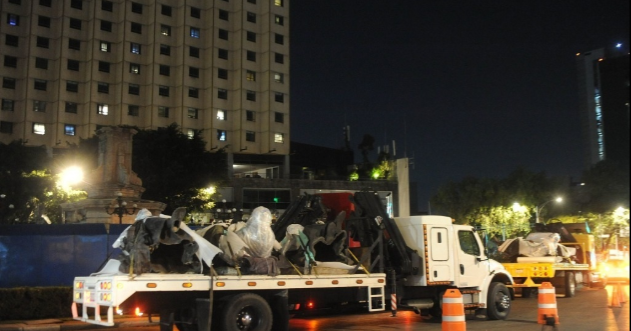
By Hermann Bellinghausen
The 12th of October, 2020 could have been the day Christopher Columbus fell from his pedestal on the Paseo de la Reforma. The authorities of the capital though preferred to preempt the announced demolition during an annual mobilization that for a short while replaced Columbus Day, (El Día de la Raza) which no one dares to commemorate. The distinguished Knights of Columbus (nicknamed by the resentful masses as Don Cristobal’s Mules), an ultra-right-wing elite that dominated the Guadalupan and Columban festivities, were erased from the scene. In the civic calendar, the discovery of America gave way to a euphemistic meeting of two worlds.
The revolt had started and there was no going back. Against any anthropological, political or demographic forecast, the original peoples of the continent recovered their voice and presence. Better said, they gained a voice and presence that they never had before.
Although the transformation in the collective consciousness of the so-called Indians (Indians, Native Americans, Aborigines, native peoples) dates back to before – in some cases, as in the Andean region, to the 1930s – the breakthrough date is 1992. The festivities for the Fifth Centennial of the restored crown and the eager Spanish-American governments were driven by an unprecedented continental awakening, which on October 12 of that year was manifested in Quito and San Cristóbal de Las Casas with a new impulse: that of the collective vindication of deep America.
In Ecuador the people drew bows and arrows. In Chiapas, the ropes and the sledgehammers. In the old Ciudad Real, the indigenous commemoration rewrote history. The Arisco Indians frightened the ladino population and the government looked down on them. In an action that was perceived as excessive, a group of Mayan protesters knocked down the statue of the conqueror and perpetrator of genocide Diego de Mazariegos.
The recovery of memory began to expose the great conquistadors for what they were, murderers. Columbus was the first (or his henchmen), and if he wasn’t the worst, it’s because he lacked the time that the Spanish and Portuguese who followed him had. Some time later, the Dutch, French and English would join the ranks of the merciless.
As the Roman Empire proves better than anyone, History is written by the victors. This does not save the empires from decadence and defeat, even after many years. For the dominant societies of the hemisphere, the indigenous people remain a poorly -resolved inconvenience, but the statues fall like bowling pins in the end, just as the discoverers knocked down idols and temples in their time. This speaks not only of an awakening, but of a loss of fear. The rumble of the fall Mazariegos in Santo Domingo’s plaza was heard a year later when the armed uprising of the Zapatista Army of National Liberation occupied San Cristobal and other plazas.
Throughout America, the indigenous uprising could no longer be stopped. The new consciousness (and conscience) finally allowed seeing the white man’s heroes as cruel murderers, whether they were Andrew Jackson or General Roca and Diaz. Literature, from Ercilla to Borges, suddenly fell on the wrong side. In Mexico, the Revolution resulted in a sort of vindication with institutional, academic and literary indigenism, closer to pity and in the spirit of the gravedigger. The genocide, even if slow, never went away, and continues crouched in the paternalistic good intentions of Lopez Obrador, which resemble those of Echeverria, which resembled those of Cardenas, who resembled those of…
This mentality has already expired. At least for the most conscious and free sectors of the American Indian. From Canada to Chile the wound grows as does the outcry. The statues of the slavers, exterminators and tamers are falling, one after another, to the dustbin of History.
Old brands, pale nostalgia, and poorly-disguised shame in the Creole attempts to ask forgiveness and to demand of the Old World, are useless apologies without correlation to the reality half a millennium later. Beyond the challenged kings and questioned pontiffs, the victory of the peoples is prolonged by their sustained life and the recovery of memory. As a challenge to urban planning and to law and order, the statues will continue to fall. They have become another stage of political debate. Where it can, the State defends them, but in indigenous hands the History of America is being radically reshaped.
This piece was originally published in Spanish in La Jornada on October 12, 2020. https://www.jornada.com.mx/2020/10/12/cultura/a08a1cul This English interpretation has been re-published by Schools for Chiapas.
